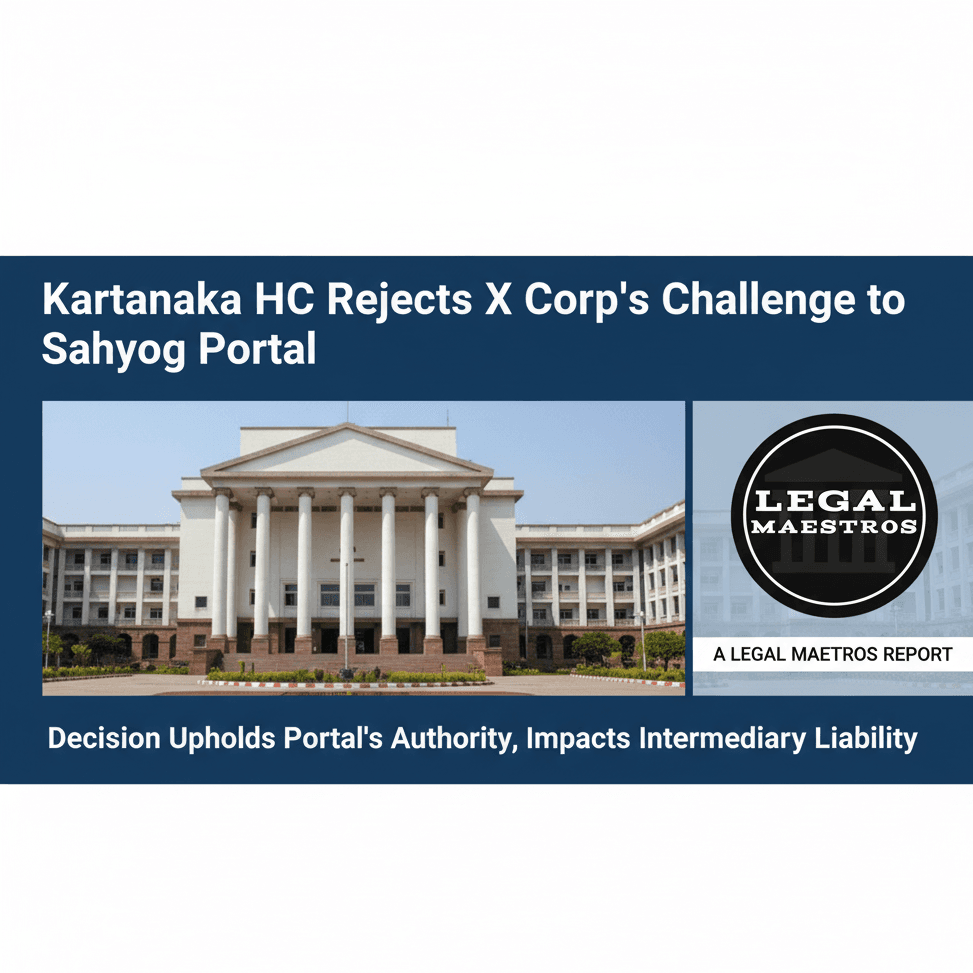
Karnataka HC Rejects X Corp's Challenge to Sahyog Portal
A Landmark Ruling in Digital Regulation
This is a major ruling that the Karnataka High Court has made in refusing a petition by X Corp, the company that was earlier referred to as Twitter. The court case was filed against Sahyog portal of the central government, a web application that was created to send takedown requests and other legal messages to social networking companies. This decision strengthens the system used by the government to censor the content of the internet, so that platforms such as X are obligated to act according to instructions made by the government in this system.
The ruling made by the court is a critical milestone toward the current debate between social media titans and the Indian government on the subject of content moderation and legality. X Corp had also challenged the portal on a number of grounds that it simplified the issuance of the blocking orders to such an extent that it was not subject to the required legal protection. The court however, determined the portal to be more or less a procedural aid that exists in the current legal framework and hence justifying its usage by government agencies.
This ruling has far-reaching consequences on any social media intermediaries that are doing business in India. It establishes the model that the government uses to handle online information and holds platforms with one and only one system of receiving and processing legal requests by law enforcement agencies and other legitimate agencies. Acceptance of the challenge of the X Corp would imply that the Sahyog portal would remain the specific channel through which such communications would be made hencewith, with the intention of enhancing efficiency and responsibility in the content regulation procedure.
For any queries or to publish an article or post or advertisement on our platform, do call at +91 6377460764 or email us at contact@legalmaestros.com.
The legal battle was initiated when X Corp challenged the foundation and mode of operation of Sahyog portal. The platform has argued that the portal streamlined the process of issuance of takedown notices without offering a sufficient opportunity to review or appeal prior to the issuance of an order to take down the content. This, it claimed, might have a possible effect of silencing of legitimate speech and violation of the rights of the platform and the users.
The Core of the Conflict
The Ministry of Electronics and Information Technology (MeITY) launched the portal known as Sahyog to serve as an online interface. Its main aim is to facilitate the intervention between the government and the social media. This portal will enable the respective officers to issue notices in accordance with Section 69A of the Information Technology (IT) Act, 2000, which gives the government the power to deny people access to any kind of information in its best judgment, in the name of national security, public order, or other mentioned reasons.
Prior to the introduction of the Sahyog portal, these notices were usually delivered in the traditional way, e.g. email, and this may cause delays, difficulties with tracking and absence of a central record keeping system. The portal was developed to address these inefficiencies through establishment of a secure single point of issuing, receiving and tracking compliance with these legal orders. This would be meant to expedite the process and make it more open to the agencies involved.
For any queries or to publish an article or post or advertisement on our platform, do call at +91 6377460764 or email us at contact@legalmaestros.com.
The reason why the government developed the portal was based on the fact that there was a need to have a stronger and more effective system that would manage the growing amount of online contents that may negatively affect the interests of people or national security. The intention of the government to focus on the centralization of the process was to make sure that the takedown orders were as speedy as possible and compliance was easily monitored. This system also offers a digital record of each notification that is given and this increases accountability on both ends.
In the case of social media companies, the portal could be taken as a single point of contact in which all such legal directives would be received by different authorized agencies within the country. This removes the muddiness of addressing several channels of communication and offers an official and precise report of the requests. The side of the government has been that this system in fact is beneficial to the platforms, because it offers clarity and a uniform way of compliance.
Understanding the Sahyog Portal
X Corp, in its legal appeal, expressed the substantive issues of procedural fairness of the Sahyog portal. The company claimed that the system was speedy and efficient at the cost of due process. One of the major criticisms was that the portal lacked a mechanism to have a fair hearing or that the platform has an opportunity to argue its case before a blocking order is dispatched. This according to X Corp was a contravention of the principles of natural justice.
For any queries or to publish an article or post or advertisement on our platform, do call at +91 6377460764 or email us at contact@legalmaestros.com.
The platform also had some worries that the automated nature of the portal may result in an abuse of power. It was concerned that the lack of difficulty in making a notice using a digital interface could lead to an increase in the number of takedown orders with little or no adequate ground to support each of them. This was the focus of the petition by X Corp that pointed out that the system could be manipulated to censor dissent or filter out content that is critical of the government and thus the production of free speech over the internet is chilled.
Moreover, X Corp argued that there was no need to create a new law especially the IT Act and the rules that accompany it, given that there was already a given procedure with regard to the administration of blocking orders. The position of the company was that the Sahyog portal was a break in these traditional norms. It claimed that a portal based system was to be introduced formally with the law being amended as opposed to being an executive or administrative action.
The essence of the argument by X Corp was that the Sahyog portal had changed the nature of the law substantially in that it emphasized the speed of compliance. The platform believed that this strategy could not enable its prudent consideration when making decisions that affect freedom of expression. The company wanted that the judiciary would review the issue in order to have proper checks and balances to avoid abuse of the content regulation system.
For any queries or to publish an article or post or advertisement on our platform, do call at +91 6377460764 or email us at contact@legalmaestros.com.
The High Court’s Decisive Verdict
When dismissing the petition of X Corp, The Karnataka High Court dwelt in the interpretation of the role of Sahyog portal. The court held that the portal did not constitute a new law but it was an instrument to enforce the provisions of the IT Act already in place to greater effect. It was considered an improvement of the process, the shift of communication channel, and not the change in the legal rights and responsibilities of the social media.



![JOB POST: Junior Associate at ASM Law Chambers, Jaipur [Freshers]](https://legalmaestros.com/wp-content/uploads/2025/11/Gemini_Generated_Image_8wrxer8wrxer8wrx-768x708.png)

